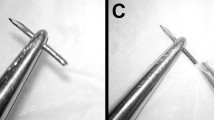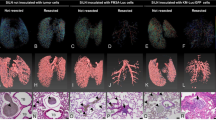Abstract
The Lewis lung tumor has been extensively studied in both syngeneic and allogeneic mouse models. However, its metastatic potential and mechanism are poorly understood. The aim of the present study was to develop a highly metastatic lymph-node targeting, imageable model of the Lewis lung carcinoma in a syngeneic host. We report here a syngeneic model of the Lewis lung carcinoma in which the carcinoma cells are labeled with green fluorescent protein (GFP). The tumor cells were transplanted in the dorsal side of the ear of C57-B16 mice in order to give the tumor cells access to the lymphatic system. This model of the Lewis lung carcinoma extensively metastasized to numerous lymph nodes throughout the body of the animal as well as visceral organs, as visualized by fluorescence microscopy using the bright GFP signal. Twenty-one different metastatic sites, including lymph nodes throughout the body, were identified among the cohort of transplanted animals. The data demonstrate a predilection of the Lewis lung carcinoma for lymphatic pathways for metastasis throughout the animal body. The concomitant macrometastases to the visceral organs observed in this model may be remetastasis from the lymph nodes. This model of the Lewis lung carcinoma should be very useful in defining cellular trafficking and targeting mechanisms of metastasis, in particular those involving lymphatic pathways.
Similar content being viewed by others
References
K Sugiura CC. Stock (1955) ArticleTitleStudies in a tumor spectrum. III. The effect of phosphoramides on the growth of a variety of mouse and rat tumors Clinical & Experimental Metastasis 15 38–51
M O‘Reilly L Holmgren Y Shing et al. (1994) ArticleTitleAngiostatin: A novel angiogenesis inhibitor that mediates the suppression of metastases by a Lewis lung carcinoma Clinical & Experimental Metastasis 79 315–28
I Fichtner S. Tanneberger (1987) ArticleTitlePreoperative (neoadjuvant) chemotherapy in the murine Lewis lung carcinoma and possible implications for clinical use Clinical & Experimental Metastasis 7 227–333
JC Himmele B Rabenhorst D. Werner (1986) ArticleTitleInhibition of Lewis lung tumor growth and metastases by Ehrlich ascites tumor growing in the same host Clinical & Experimental Metastasis 111 160–5
E Gorelik S Segal M. Feldman (1980) ArticleTitleControl of lung metastases progression in mice: Role of growth kinetics of 3LL Lewis lung carcinoma and host immunity reactivity Clinical & Experimental Metastasis 65 1257–64
DC Prasher VK Eckenrode WW Ward et al. (1992) ArticleTitlePrimary structure of the Aequorea victoriagreen-fluorescent protein Clinical & Experimental Metastasis 111 229–33
M Chalfie Y Tu G Euskirchen et al. (1994) ArticleTitleGreen fluorescent protein as a marker for gene expression Clinical & Experimental Metastasis 263 802–5
B Rashidi M Yang P Jiang E Baranov Z An X Wang AR Moossa RM. Hoffman (2000) ArticleTitleA highly metastatic Lewis lung carcinoma orthotopic green fluorescent protein model Clinical & Experimental Metastasis 18 57–60
T. Corbett (2002) Tumor models in cancer research BA Teicher (Eds) Transplantable Syngeneic Rodent Tumors. Humana Press Totowa, NJ 41–71
IR. Hart (1982) ArticleTitle‘Seed and soil’ revisited: Mechanisms of site-specific metastasis Clinical & Experimental Metastasis 1 5–16
T Ikoma T Takahashi S Nagano et al. (2004) ArticleTitleA definitive role of RhoC in metastasis of orthotopic lung cancer in mice Clinical & Experimental Metastasis 10 1192–200
K Ichiki N Mitani Y Doki H Hara et al. (2000) ArticleTitleRegulation of activator protein-1 activity in the mediastinal lymph node metastasis of lung cancer Clinical & Experimental Metastasis 18 539–45
T Yamaura Y Doki K Murakami I. Saiki (1999) ArticleTitleModel for mediastinal lymph node metastasis produced by orthotopic intrapulmonary implantation of lung cancer cells in mice Clinical & Experimental Metastasis 12 197–204
K Murakami T Yamaura K Suda et al. (1999) ArticleTitleTAC-101 (4-[3,5-bis (trimethylsilyl) benzamido] benzoic acid) inhibits spontaneous mediastinal lymph node metastasis produced by orthotopic implantation of Lewis lung carcinoma Clinical & Experimental Metastasis 90 1254–61
Y Doki K Murakami T Yamaura et al. (1999) ArticleTitleMediastinal lymph node metastasis model by orthotopic intrapulmonary implantation of Lewis lung carcinoma cells in mice Clinical & Experimental Metastasis 79 1121–6
Y Dohi S Sunada M Aoki et al. (1993) ArticleTitleEradication of metastatic tumour cells from lymph nodes by local administration of anti-CD3 antibody Clinical & Experimental Metastasis 36 357–63
M Yang S Hasegawa P Jiang et al. (1998) ArticleTitleWidespread skeletal metastatic potential of human lung cancer revealed by green fluorescent protein expression Clinical & Experimental Metastasis 58 4217–21
L Weiss PM. Ward (1987) ArticleTitleLymphogenous and hematogenous metastasis of Lewis lung carcinoma in the mouse Clinical & Experimental Metastasis 40 570–4
AA Dunne R Mandic A Ramaswamy et al. (2002) ArticleTitleLymphogenic metastatic spread of auricular VX2 carcinoma in New Zealand white rabbits Clinical & Experimental Metastasis 22 3273–9
T Shiohara G Moellmann K Jacobson et al. (1987) ArticleTitleAntitumor activity of class II MHC antigen-restricted cloned autoreactive T cells. II. Novel immunotherapy of B16 melanomas by local and systemic adoptive transfer Clinical & Experimental Metastasis 138 1979–86
Author information
Authors and Affiliations
Corresponding author
Rights and permissions
About this article
Cite this article
Bobek, V., Kolostova, K., Pinterov, D. et al. Syngeneic lymph-node-targeting model of green fluorescent protein-expressing Lewis lung carcinoma. Clin Exp Metastasis 21, 705–708 (2005). https://doi.org/10.1007/s10585-004-8118-8
Received:
Accepted:
Published:
Issue Date:
DOI: https://doi.org/10.1007/s10585-004-8118-8




